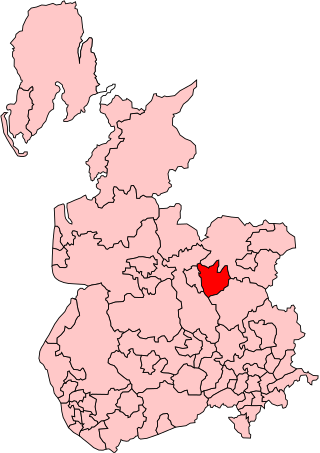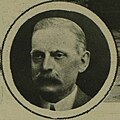
Monmouth is a county constituency of the House of Commons of the Parliament of the United Kingdom. The seat was created for the 1918 general election. Since 2005 the Member of Parliament (MP) has been David Davies of the Conservative Party.
East Grinstead was a parliamentary constituency in the Kingdom of England, the Kingdom of Great Britain, and the United Kingdom. It first existed as a Parliamentary borough from 1307, returning two Members of Parliament to the House of Commons elected by the bloc vote system. The borough was disfranchised under the Reform Act 1832, but the name was revived at the 1885 election when the Redistribution of Seats Act created a new single-member county division of the same name.

Accrington was a parliamentary constituency of the House of Commons of the Parliament of the United Kingdom from 1885 to 1983. It elected one Member of Parliament (MP) by the first-past-the-post system of election.
Altrincham was a county constituency of the House of Commons of the Parliament of the United Kingdom from 1885 to 1945. It elected one Member of Parliament (MP) by the first past the post system of election.
Isle of Ely was a county constituency represented in the House of Commons of the Parliament of the United Kingdom, centred on the Isle of Ely in Cambridgeshire. Until its abolition in 1983, it elected one Member of Parliament (MP) by the first past the post system of election.

Balham and Tooting was a constituency in South London, which returned one Member of Parliament (MP) to the House of Commons of the Parliament of the United Kingdom. It was created for the 1918 general election and abolished for the 1950 general election.
Birkenhead East was a parliamentary constituency centred on the Birkenhead area of Merseyside. It returned one Member of Parliament (MP) to the House of Commons of the Parliament of the United Kingdom, elected by the first past the post voting system.

Salford North was a parliamentary constituency in the City of Salford in Greater Manchester from 1885 until 1950. It returned one Member of Parliament (MP) to the House of Commons of the Parliament of the United Kingdom.
Swindon was a parliamentary constituency in the town of Swindon in Wiltshire, England.

Newton was a parliamentary borough in the county of Lancashire, in England. It was represented by two Members of Parliament in the House of Commons of the Parliament of England from 1559 to 1706 then of the Parliament of Great Britain from 1707 to 1800 and of the Parliament of the United Kingdom from 1801 until its abolition in 1832.
Birmingham West was a parliamentary constituency represented in the House of Commons of the Parliament of the United Kingdom. It returned one Member of Parliament (MP), elected by the first-past-the-post voting system.

Mile End was a parliamentary constituency centred on the Mile End district of the East End of London. It returned one Member of Parliament (MP) to the House of Commons of the Parliament of the United Kingdom.
Leeds North was a borough constituency in the city of Leeds, West Yorkshire, which returned one Member of Parliament (MP) to the House of Commons of the Parliament of the United Kingdom, elected by the first past the post voting system.
Birmingham King's Norton was a constituency of the House of Commons of the Parliament of the United Kingdom from 1918 to 1955. It elected one Member of Parliament (MP) by the first-past-the-post system of election.
Manchester Clayton was a parliamentary constituency in the city of Manchester. It returned one Member of Parliament (MP) to the House of Commons of the Parliament of the United Kingdom, elected by the first past the post system.
Richmond (1918–1983) was a parliamentary constituency centred on the town of Richmond. The seat mirrored for its first 47 years a small northern projection of Surrey. For the final 18 years its area, in local government, fell into the new county of Greater London.

East Ham South was a parliamentary constituency centred on the East Ham district of London, which was in Essex until 1965. It returned one Member of Parliament (MP) to the House of Commons of the Parliament of the United Kingdom, elected by the first past the post voting system.

East Ham North was a parliamentary constituency centred on the East Ham district of London, which was in Essex until 1965. It returned one Member of Parliament (MP) to the House of Commons of the Parliament of the United Kingdom, elected by the first past the post voting system.
Monmouth Boroughs was a parliamentary constituency consisting of several towns in Monmouthshire. It returned one Member of Parliament (MP) to the House of Commons of the Parliaments of England, Great Britain, and finally the United Kingdom; until 1832 the constituency was known simply as Monmouth, though it included other "contributory boroughs".
Horsham and Worthing was a county constituency in West Sussex, centred on the towns of Horsham and Worthing in West Sussex. It returned one Member of Parliament (MP) to the House of Commons of the Parliament of the United Kingdom, elected by the first past the post system.









